INDUCTIVE METHOD
We will shortly review the 3 steps of Inductive Method:
- Observation, meaning to carefully observe, what is given in the text. Look! Look! Look! We will do different observations one by one following
- Interpretation, meaning to try to understand what this meant to the people who first heard this prophets words (first hearers) or who read his writings (first readers)?
- Application, meaning we will ask: What does this mean for me today? What thoughts, attitudes or behavior do I need to change in the light of this text? What will I do in response to this text?
Instruction
Read the prophecy in Amos out loud in one setting. The reason for reading out loud is that if you read with your eyes, speak with your mouth and hear with your ears you will remember better what you read.
The goal of the first reading is not to catch all details but just to get a first impression of the book and to observe some main topics the prophet talks about.
OBSERVATION
We will now start with detailed observation step by step. Since the text of Amos is long, we will show only the 1st chapter, but you need to keep doing the observation for all 9 chapters of Amos.
01a Observation question: Who? > God
Instruction
Read through Amos and color with one color (light yellow) every time the name of God occurs or he is referenced in the text.
Example

Findings
Your text should look roughly like this:
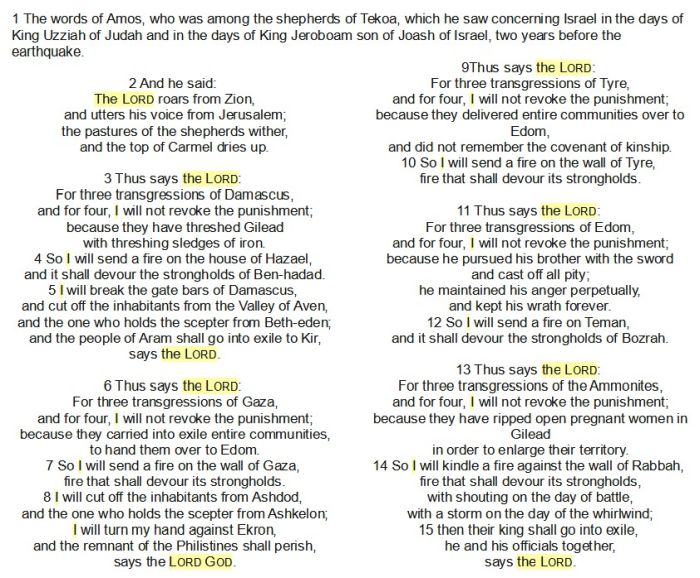
01b Observation question: Who? > humans
Instruction
Read through Amos again and color with yellow every time a person or a group of persons is mentioned.
Example

Findings
Your text should now look roughly like this:

01c Observation question: Who? > nations
Instruction
Read through Amos again and color with dark yellow every word that refers to a nation or people.
Example

Findings
Your text should now look roughly like this:
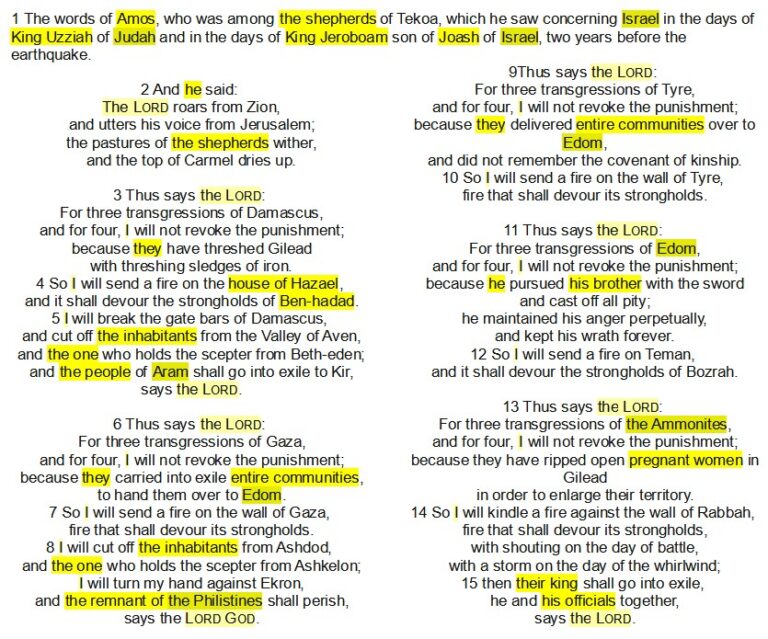
02 Observation Question: Where? > locations
Instruction
Read Amos again and color with grey any geographical location, city name, area etc.
Example

Findings
Your text should now look roughly like this:
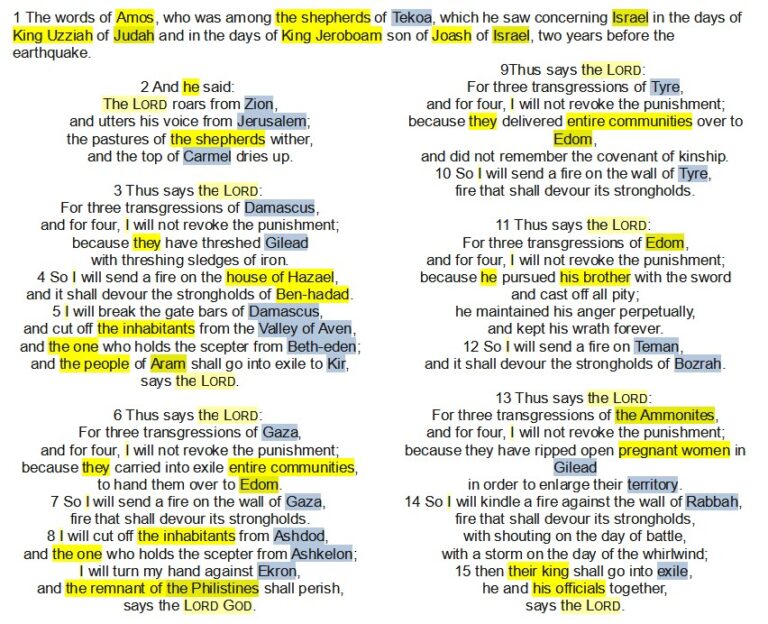
03 Observation Question: When? > time elements
Instruction
Read Amos again and color with light grey that refer to time. For example “in the days of”, “now”, “when” etc.
Example

Findings
Your text should now look roughly like this:
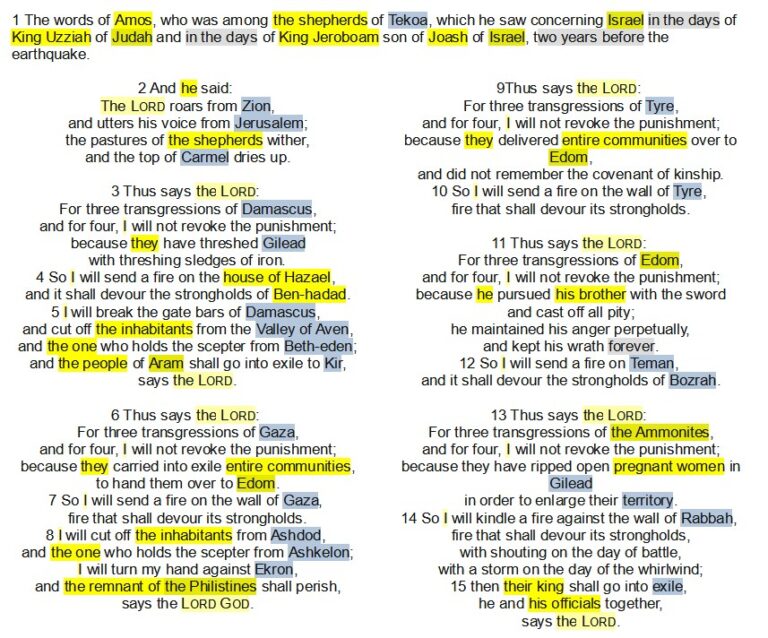
04 Observation Question : Reason? Intention?
Instruction
Read Amos again and Color with dark red any words that express a reason (like “because”, “for”, “therefore”, …) or an intention (like “so”, “so that”, …).
Example

Findings
Your text should now look roughly like this:
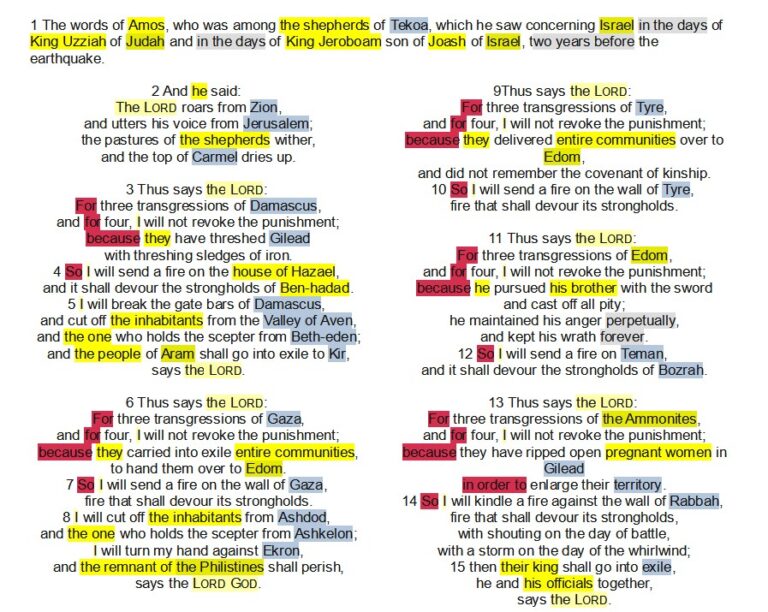
05 Observation Question : Repeated theme: Israel’s sin, reasons for judgment
Actually, in the first two chapters of Amos we find entire verses which are “reasons” for judgment. They are always introduced with the same sentence “For three transgressions, … and for four, I will not revoke the punishment “. Color the reasons following with a bracket.
Example
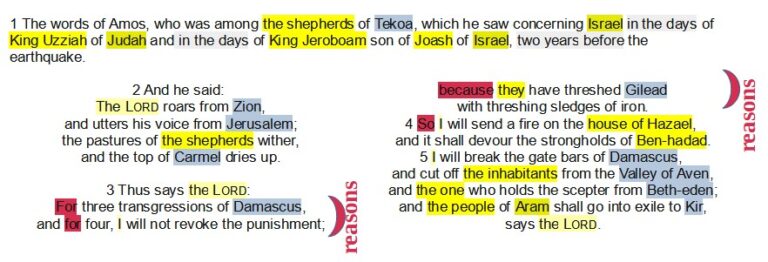
Findings
Your text should now look roughly like this:
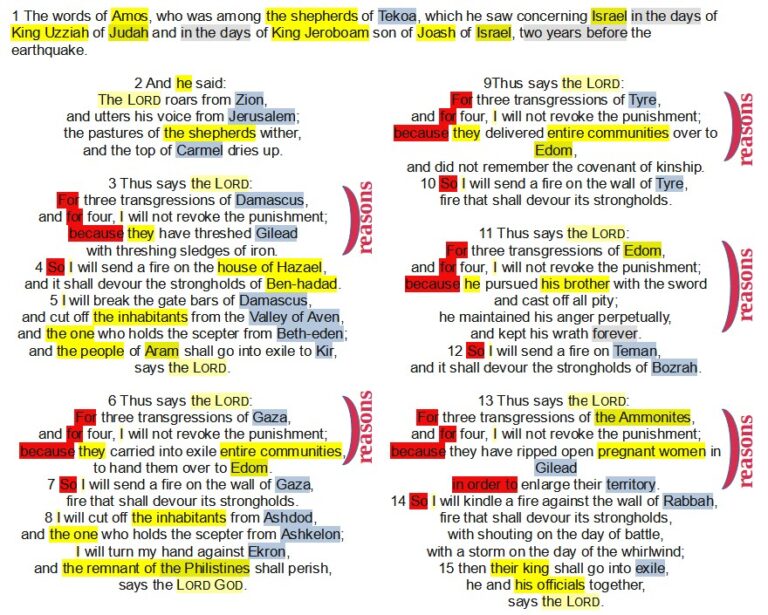
Instruction
Read Amos again, especially from chapter 2 onward, and color in the text or in the margins with dark red any passage where God describes what is the sin of Israel or the nations, the reasons he will judge them.

Findings
There are many powerful and emotional passages, for example:
- Amos 2:1 (Moab), Amos 2:4 (Judah) … after this, all sin described is Israel’s
- Amos 2:6-8
- Amos 2:12
- Amos 3:9-10,14
- Amos 4:1, 4-5
- Amos 5:7, 10-13, 18-23
- Amos 6:1, 4-6, 13
- Amos 7:4-6
- Amos 9:8
06 Observation Question: Repeated Theme - descriptions or predictions of judgment
Instruction
Read Amos again and color with grey in the text or in the margin whenever God declares a judgment or describes a future judgment.

Example

Findings
Your text should now look roughly like this:
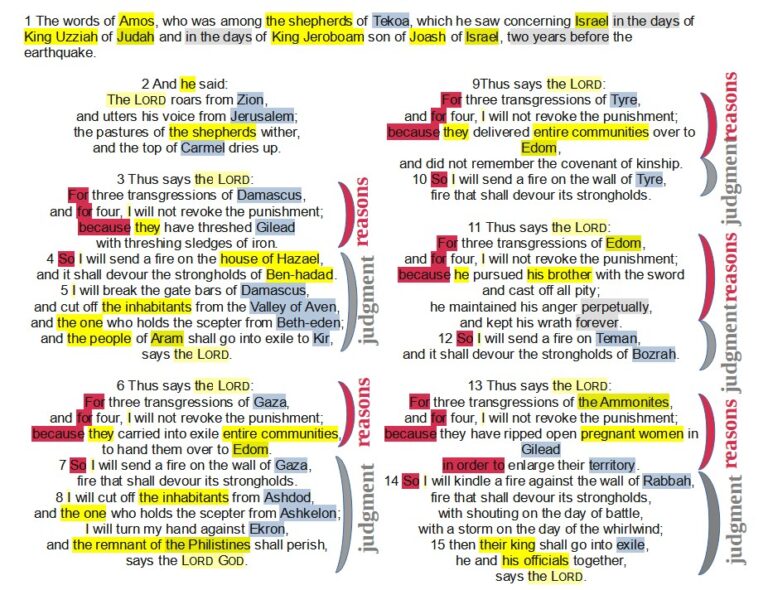
There are many other passages of judgment throughout the book of Amos:
- Amos 3:11-15
- Amos 4:1-3
- Amos 4:6-12 partial judgments not heeded
- Amos 5:1-4 judgment described in past tense, the way it will look once it happened.
- Amos 5:16-20
- Amos 6:8-14
- Amos 7:2, 4, 8-9
- Amos 8:2-3 basket of summer fruit
- Amos 8:9-14
- Amos 9:1-4
- Amos 9:9-10
07 Observation Question: Repeated Theme: Descriptions of God
Instruction
Read Amos again and Color with brown in the text or in the margin wherever you see a description of God. What does it say about God?

Example
Amos 1:2 “The LORD roars from Zion, and utter his voice from Jerusalem, the pastures wither … Carmel dried up”
- God is described as a lion, powerful, fearful, touching and judging the world.
Findings
Amos 1:2 “The LORD roars from Zion, and utter his voice from Jerusalem, the pastures wither … Carmel dried up”
- God is described as a lion, powerful, fearful, touching and judging the world.
Amos 4:13 “For lo, the one who forms the mountains, creates the wind, reveals his thoughts to mortals, makes the morning darkness, and treads on the heights of the earth – the LORD, the God of hosts, is his name!”
- God is the powerful Creator, of this universe, this world and humankind. God is involved, maintaining, touching, interfering … also in the form of giving revelation.
Amos 5:8-9 “The one who made the Pleiades and Orion, and turns deep darkness into morning, and darkens the day into night, who calls for the waters of the sea, and pours them out on the surface of the earth, the LORD is his name, who makes destruction flash out against the strong, so that destruction comes upon the fortress” …
- Again God is the powerful Creator, of this universe, this world and humankind. God is involved, maintaining, touching, interfering … here in the form of judging the strong and destroying their false security.
Amos 9:5-6 … “The Lord, GOD of hosts, he who touches the earth and it melts, and all who live in it mourn, and all of it rises like the Nile, and sinks again, like the Nile of Egypt; who builds his upper chambers in the heavens, and founds his vault upon the earth; who calls for the waters of the sea, and pours them out upon the surface of the earth – the LORD is his name.”
- As before.
What is the message and purpose of these descriptions in Amos? Why do we find them here? We will try to answer that in the Unit “Amos 03 – Interpreting the main themes”
08 Observation Question: Repeated Theme - the rich, carelessness versus the poor
Instruction
Read Amos again and color with a dark red star in the text or in the margin wherever you see a description of the rich, complacent, careless, oppressive people on the one side and the poor, oppressed on the other side. This repeated theme will often run parallel to “Repeated theme: reasons for judgment”, hence the use of the same color.

Example
Amos 2:6ff “because they sell the righteous for silver, and the needy for a pair of sandals – they who trample the head of the poor into the dust of the earth, and push the afflicted out of the way”
Findings
- Amos 3:9-11 “Assemble yourselves on Mount Samaria, and see what great tumults are within it, and what oppressions are in its midst. They do not know how to do right, says the LORD, those who store up violence and robbery in their strongholds”
- Amos 4:1 “Hear this word, you cows of Bashan who are on Mount Samaria, who oppress the poor, who crush the needy, who say to their husbands, bring something to drink!”
- Amos 5:10-12 “They hate the one who reproves in the gate, and they abhor the one who speaks the truth. Therefore because you trample on the poor and take from them levies of grain, you have built houses of hewn stone, but you shall not live in them … For I know how many are your transgressions, and how great are your sins – you who afflict the righteous, who take a bribe, and push aside the needy in the gate”
- Amos 5:23-24 “Take away from me the noise of your songs; I will not listen to the melody of your harps. But let justice roll down like waters, and righteousness like an ever-flowing stream”
- Amos 6:1 “Alas for those who are at ease in Zion, and for those who feel secure on Mount Samaria”
- Amos 6:4-6 “Alas for those who lie on beds of ivory, and lounge on their couches, and eat lambs from the flock, and calves from the stall; who sing idle songs to the sound of the harp … who drink wine from bowls and anoint themselves with the finest oils, but are not grieved over the ruin of Joseph!”
- Amos 8:4 “Hear this, you that trample on the needy, and bring to ruin the poor of the land, saying, When will the new moon be over so that we may sell grain and the sabbath, so that we may offer wheat for sale? We will make the ephah small and the shekel great, and practice deceit with false balances, buying the poor for silver and the needy for a pair of sandals, and selling the sweepings of the wheat”
This is a very strong and explicit repeated theme. Actually, injustice towards the poor is the number one sin that God accuses Israel of.
09 Observation Question: Repeated Theme - false religiosity, false security
Instruction
Read Amos again and color with a dark red cross in the text or in the margin wherever you see a description of false religiosity, of supposedly spiritual acts that God hates. This repeated theme will often run parallel to “Repeated theme: reasons for judgment”, hence the use of the same color.

Example
Amos 4:4-5 “Come to Bethel and transgress, to Gilgal – and multiply transgression; bring your sacrifices every morning, your tithes every three days; bring a thank offering of leavened bread, and proclaim freewill offerings, publish them; for so you love to do, O people of Israel!”
Findings
- Amos 2:8 “They lay themselves down beside every altar” implies religiosity, yet immorality, looseness, idolatry.
- Amos 2:12 “But you made the nazirites drink wine, and commanded the prophets, saying, you shall not prophesy” implies the opposing of any true faith or devotion, the resisting of truth, conscience and the Word of God.
- Amos 4:4-5 “Come to Bethel and transgress, to Gilgal – and multiply transgression; bring your sacrifices every morning, your tithes every three days; bring a thank offering of leavened bread, and proclaim freewill offerings, publish them; for so you love to do, O people of Israel!” There is no lack of visiting the temple, of sacrificing, even of tithes and religious observance. Instead of repentance and atonement it is self-sufficient religiosity.
- Amos 5:5 “Do not seek Bethel, and do not enter into Gilgal or cross over to Beer-Sheba”
- Amos 5:21-24 “I hate, I despise your festivals, and I take no delight in your solemn assemblies. Even though you offer me your burnt offerings and grain offerings, I will not accept them; and the offerings of well-being of your fattened animals I will not look upon. Take away from me the noise of your songs; I will not listen to the melody of your harps.”
Again this is a very strong and explicit repeated theme. Through the biting words of Amos God cuts right through any fake religiosity, through outward acts of devotion, through any outward displays of one’s own righteousness. This is combined with false security or self-confidence:
- Amos 2:13-16,6:13 “Have we not by our own strength taken Karnaim for ourselves?”
- Amos 6:8 “I abhor the pride of Jacob and hate his strongholds”
- Amos 9:10 “All the sinners of my people shall die by the sword, who say, Evil shall not overtake of meet us.” which is so opposite to fear of God, to walking in relationship with a holy God, open to his correction.
10 Observation Question: Repeated Theme - words of hope / call to repentance
Instruction
Read Amos again and color with a green star in the text or in the margin wherever you see a words of hope, or challenges of repentance, showing that there is still hope, there is still something God wants them to do.

Example
- Amos 5:4 “Seek me and live; but to not seek Bethel …”
Findings
Amos calls with great urgency and great seriousness for repentance:
- Amos 5:4 “Seek me and live; but to not seek Bethel …”
- Amos 5:6 “Seek the LORD and live, or he will break out against the house of Joseph like fire, and it will devour Bethel, with no one to quench it.”
- Amos 5:14 “Seek good and not evil, that you may live; and so the LORD, the God of hosts, will be with you, just as you have said. Hate evil and love good, and establish justice in the gate; it may be that the LORD, the God of hosts, will be gracious to the remnant of Joseph.”
- Amos 5:24 “But let justice roll down like waters, and righteousness like an ever-flowing stream”
This is important, for with the prophets a call to repentance means that there is still hope. But it has to be taken seriously. But Amos also speaks of a greater hope beyond, beyond the catastrophic destruction of Israel he announces:
- Amos 9:11-15 “In that day I will raise up the booth of David that is fallen and repair its breaches, and raise up its ruins and rebuild it as in the days of old, 12 that they may possess the remnant of Edom and all the nations who are called by my name,” declares the Lord who does this. 13 “Behold, the days are coming,” declares the Lord, “when the plowman shall overtake the reaper and the treader of grapes him who sows the seed; the mountains shall drip sweet wine, and all the hills shall flow with it. 14 I will restore the fortunes of my people Israel, and they shall rebuild the ruined cities and inhabit them; they shall plant vineyards and drink their wine, and they shall make gardens and eat their fruit. 15 I will plant them on their land, and they shall never again be uprooted out of the land that I have given them,” says the Lord your God.”
Though there are many more things that could be observed in Amos, we will leave it here and continue on to understanding the historical background of the book of Amos > see Unit Amos 02 “Historical background”.